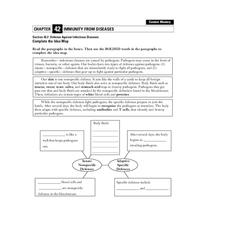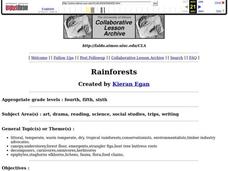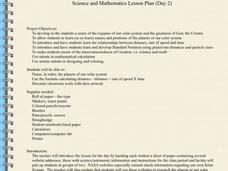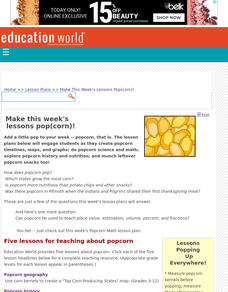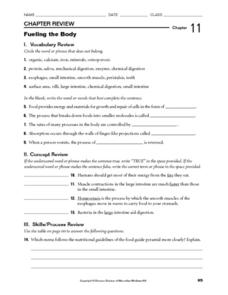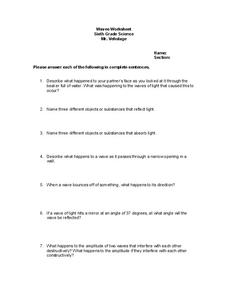Curated OER
Making Your Own Sampling Tools
Students examine cause-and-effect relationship between human attitudes and behavior in the environment. They also assist citizens in increasing their sensitivity and stewardship for the environment.
Curated OER
Cells Vocabulary List and Definitions
In this cells worksheet, students learn the important vocabulary pertaining to cell biology. Students read 14 words with their definitions. There are no questions to answer.
Curated OER
Groundwater
In this groundwater worksheet, students use 12 given terms and match them to their definitions related to characteristics of groundwater and the components of the ground where the water travels. Students also fill in 5 blanks with given...
Curated OER
Diffraction of Laser Light, Polarization and Color Filters
High schoolers investigate light behavior by conducting a series of experiments. In this physics lesson plan, students calculate the wavelength of the light source using an equation. They determine what color is produced when light of...
Curated OER
Defense Against Infectious Diseases
In this infectious diseases activity, students read about the two types of defenses the body has against pathogens: innate (nonspecific) and adaptive (specific). Students then complete a graphic organizer by filling in 11 blanks.
Curated OER
Exploring Caves
Students explain why many caves have become National Parks. They determine that caves provide shelter from enemies, and from bad weather in the summer or the winter, and provide certain mineral resources. They discover that ancient art...
Curated OER
Habitats
Students examine how different living things interact with their environment. As a class, they discuss the characteristics of a habitat and write the list on the board. In groups, they focus on one habitat and create a mural of the...
Curated OER
Sorting
Students examine the concept of organization. In this library skills lesson plan, students practice ordering and sorting skills by playing the Flood Game.
Curated OER
On the Trail of the Hudson's Migratory Fish
Using data related to the fish in the Hudson River area, learners calculate distance, elapsed time, and growth. They learn about migratory fish, the life cycle of a fish, analyze a map, and answer questions.
Curated OER
The Sweet Connection
Students use maps to find what crops are dominant in areas where honey bees are raised and discuss possible correlations. They mark the top ten honey- producing states on a US map.
Curated OER
Garden In a Glove
Pupils investigate the concept of seeds and how they can germinate. They obtain seeds and isolate them in a rubber glove before transplanting them into the ground. The lesson includes a graphic organizer for observations or information.
Curated OER
Rainforests
Students watch a video about the rainforest and create a large wall mural of rainforest features. Students write a first person point of view article by an endangered rainforest animal and discuss logging.
Curated OER
Air Pollution: What Can You Do?
Students discuss and write about air pollution in their journals. They practice using new vocabulary words associated with pollution and write sentences using those words. They end the lesson by determining what they can do to fight air...
Curated OER
The Solar System
Students research the characteristics of planets in our solar system. In this space science lesson, students create a solar system model with each planet arranged according to their distance from the sun. They solve problems using the...
Curated OER
And Then there Were Nun: Trees that could be endangered by the Nun Moth Invasion
Learners read and article and become familiar with the danger to trees from the Nun Moth. In this Nun Moth lesson, students work in groups to create visual images of vocabulary words. Learners reflect on the article by assessing...
Curated OER
Make This Week's Lessons Pop(corn)!
Students create popcorn timelines, maps, and graphs; do popcorn science and math; explore popcorn history and nutrition; and munch leftover popcorn snacks too!,
National External Diploma Program Council
Capitalization Review
Using correct grammar is a capital idea! Elementary readers review the rules of capitalization, including proper nouns, abbreviations of organizations, and holidays, before correcting the errors in two sets of sentences.
Curated OER
Fueling the Body
For this nutrition worksheet, students review the organs and enzymes that are part of the digestive system. Then students review the food pyramid by comparing two menus. This worksheet has 9 fill in the blank, 4 true or false, and 5...
Curated OER
Light and Vision
In this light and vision worksheet, students will review the characteristics of light including how the eyes use light to see. This worksheet has 9 fill in the blank, 8 true or false, 9 multiple choice, and 1 short answer question.
Curated OER
Cells - Building Blocks of Life
In this cells worksheet, students review cell organelles and their functions plus the different processes that take place within cells. This worksheet has 9 matching and 5 true or false questions.
Curated OER
Ferns and Gymnosperms
In this fern and gymnosperm instructional activity, students will read about two types of vascular tissue: xylem and phloem. Then students will read about the difference between sporophytes and gametophytes. Using this information...
Curated OER
Transfer of Thermal Energy
In this thermal energy worksheet, learners will explore different ways heat is transferred including conduction and convection. Students will look at how insulators work and how room temperature can affect heat transfer. This worksheet...
Curated OER
Warming the Earth
First graders investigate how the sun warms the Earth and examine the rotation of the Earth and the sun. They create an illustration of the sun, examine a solar system model, and listen to the book "The Sun: Our Nearest Star." They also...
Curated OER
Waves Worksheet
For this light waves worksheet, students complete 7 short answer questions where they analyze and record findings about the properties of light waves.






